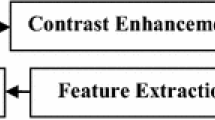Abstract
Computer aided visual inspection systems focus on identifying and categorizing the surface defects in steel manufacturing industry to improve the steel quality and minimize cost for production. Wavelet scattering network extracts the low variance image features which are translation, rotation and deformation invariant that can be used for image vision applications. In the paper, the textured surface steel defects classification based on wavelet scattering and the principal component analysis (PCA) are presented. Wavelet scattering transform is used to extract the features. PCA computes the principal components of the scattering features and builds the model. Results obtained from NEU dataset and the inferences drawn from the analysis reveal efficiency of proposed method with a better accuracy of 99.17% than other traditional methods.
Access this chapter
Tax calculation will be finalised at checkout
Purchases are for personal use only
Similar content being viewed by others
References
Bruna, J., Mallat, S.: Invariant scattering convolution networks. IEEE Trans. Pattern Anal. Mach. Intell. 35(8), 1872–1886 (2013)
Hayman, E., Caputo, B., Fritz, M., Eklundh, J.-O.: On the significance of real-world conditions for material classification. In: Pajdla, T., Matas, J. (eds.) ECCV 2004. LNCS, vol. 3024, pp. 253–266. Springer, Heidelberg (2004). https://doi.org/10.1007/978-3-540-24673-2_21
Mallat, S.: Group invariant scattering. Commun. Pure Appl. Math. 65(10), 1331–1398 (2012)
Sifre, L., Mallat, S.: Rotation, scaling and deformation invariant scattering for texture discrimination. In: 2013 IEEE Conference on Computer Vision and Pattern Recognition, pp. 1233–1240 (2013). https://doi.org/10.1109/CVPR.2013.163
Jin, Y.: Wavelet scattering and neural networks for railhead defect identification. Materials (Basel, Switzerland) 14(8), 1957 (2021). https://doi.org/10.3390/ma14081957
Andén, J., Mallat, S.: Deep scattering spectrum. IEEE Trans. Signal Process. 62(16), 4114–4128 (2014)
Ren, Z., Fang, F., Yan, N., Wu, Y.: State of the art in defect detection based on machine vision. Int. J. Precis. Eng. Manuf.-Green Technol. 1–31 (2021). https://doi.org/10.1007/s40684-021-00343-6
Gonzalez, R.C., Woods, R.E.: Image processing. Digit. Image Process. 2(1) (2007)
Song, K., Hu, S., Yan, Y.: Automatic recognition of surface defects on hot-rolled steel strip using scattering convolution network. J. Comput. Inf. Syst. 10, 3049–3055 (2014)
Liu, Z., Yao, G., Zhang, Q., Zhang, J., Zeng, X.: Wavelet scattering transform for ECG beat classification. Comput. Math. Methods Med. 2020 (2020)
Oyallon, E., Mallat, S., Sifre, L.: Generic deep networks with wavelet scattering. arXiv preprint arXiv:1312.5940 (2013)
Boudiaf, A., Moussaoui, A., Zaghdoudi, R., Mentouri, Z., Saadoune, A.: An automatic system to surface defect classification of hot rolled steel. In: International Symposium on Mechatronics and Renewable Energies El-Oued, 10–11 December 2018 (2018)
Asha, V., Bhajantri, N.U., Nagabhushan, P.: Texture Defect Detection in Gradient Space. arXiv preprint arXiv:1403.2031 (2014)
Jain, A.K., Farrokhina, F., Alman, D.: Texture analysis of automotive finishes. In: Proceedings of the SME Machine Vision Applications Conference, vol. 1, pp. 1–16 (1990)
Chen, J., Jain, A.K.: A structural approach to identify defects on textural images. In: Proceedings of the IEEE International Conference on Systems, Man, and Cybernetics, vol. 1, pp. 29–32 (1988)
Siew, L.H., Hodgson, R.M., Wood, E.J.: Texture measures for carpet wear assessment. IEEE Trans. PAMI 10 (1988)
Lee, C.S., Choi, C.-H., Choi, J.Y., Kim, Y.K., Choi, S.H.: Feature extraction algorithm based on adaptive wavelet packet for surface defect classification. In: IEEE International Conference on Image Proceedings, pp. 673–675 (1996)
Song, K., Shaopeng, H., Yan, Y.: Automatic recognition of surface defects on hot-rolled steel strip using scattering convolution network. J. Comput. Inf. Syst. 10(7), 3049–3055 (2014)
Wang, S., Xia, X., Ye, L., Yang, B.: Automatic detection and classification of steel surface defect using deep convolutional neural networks. Metals 11(3), 388 (2021)
Xiao, M., Jiang, M., Li, G., Xie, L., Yi, L.: An evolutionary classifier for steel surface defects with small sample set. EURASIP J. Image Video Process. 2017(1), 1–13 (2017). https://doi.org/10.1186/s13640-017-0197-y
Feng, X., Gao, X., Luo, L.: X-SDD: a new benchmark for hot rolled steel strip surface defects detection. Symmetry 13, 706 (2021). https://doi.org/10.3390/sym13040706
Author information
Authors and Affiliations
Corresponding author
Editor information
Editors and Affiliations
Rights and permissions
Copyright information
© 2022 The Author(s), under exclusive license to Springer Nature Switzerland AG
About this paper
Cite this paper
Simon, P., Uma, V. (2022). A Machine Learning Approach for Steel Surface Textural Defect Classification Based on Wavelet Scattering Features and PCA. In: Abraham, A., et al. Proceedings of the 13th International Conference on Soft Computing and Pattern Recognition (SoCPaR 2021). SoCPaR 2021. Lecture Notes in Networks and Systems, vol 417. Springer, Cham. https://doi.org/10.1007/978-3-030-96302-6_28
Download citation
DOI: https://doi.org/10.1007/978-3-030-96302-6_28
Published:
Publisher Name: Springer, Cham
Print ISBN: 978-3-030-96301-9
Online ISBN: 978-3-030-96302-6
eBook Packages: Intelligent Technologies and RoboticsIntelligent Technologies and Robotics (R0)



